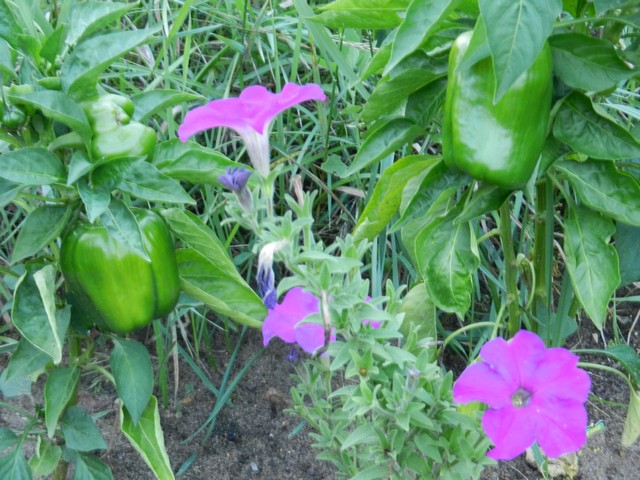
This past spring of 2012, I started looking into various flowers and herbs etc. that might help deter and prevent pests in my vegetable garden in a natural way. I wrote a post on this subject early on in the season, Herbs & Flowers to Naturally Control & Deter Pests, in which I described a few plants believed to be helpful as pest control, and made a decision on which plants I wanted to try for my own garden. In this post, I will give you an update on how things went, and whether it seemed to work.
All in all it was an interesting project, and though I did had some pest problems, I still think it was worth adding these plants to my garden.
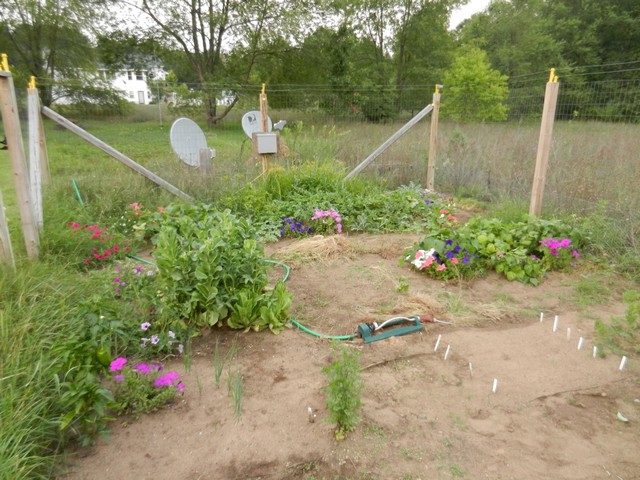
PETUNIAS
The small section of green beans definitely took the biggest hit, this year as in previous years; the petunias I planted were supposed to help control Mexican bean beetles, but I would say the effect was very limited. The plants seemed just as attacked as before, but the difference was that (amazingly enough) I did not actually see any of the worms this year. I did see one beetle, but no worms, although the evidence of them were all over. So if I decide to plant snap beans next year, I will have to do something more drastic.
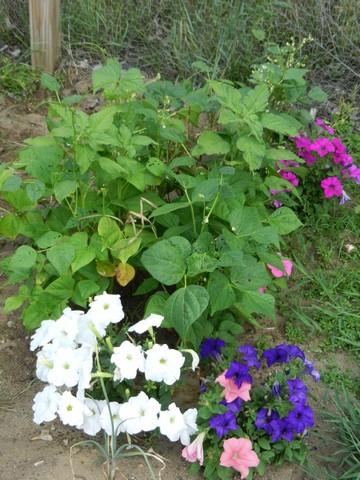
For some reason, and I’ve also noticed this before, later in the season the beetles seem to disappear and the new beans look just fine. You can still see the holes in the leaves that were attacked earlier.
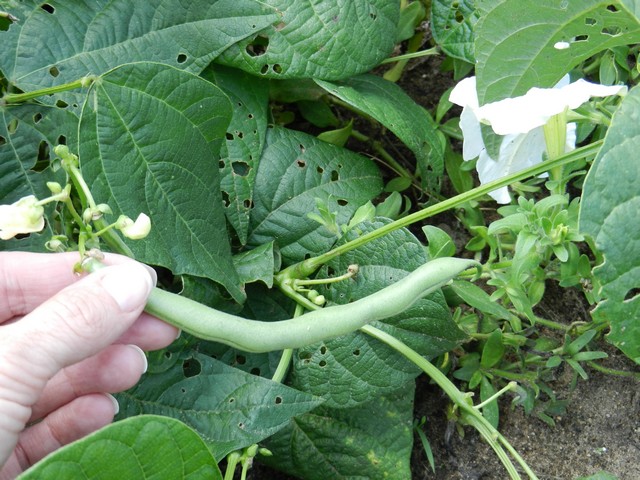
The next picture shows a bean attacked by Mexican bean beetles. If I see a mark here and there, I’ll just cut those sections off from the beans after I harvest them. But some beans look so bad that I end up throwing them in the compost.
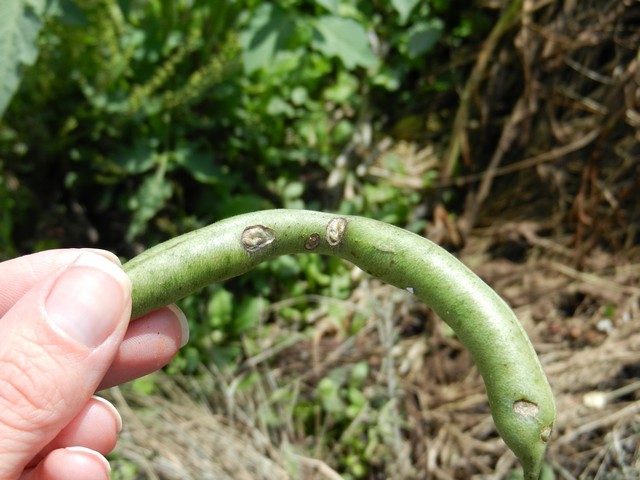
Spinosad is a spray considered safe for organic gardens, that keeps a lot of beetles and bugs at bay. Last year my plants bean plants were so badly attacked that praying with spinosad had no effect. Perhaps the infestation was too far gone by the time I started spraying; I’m wondering if it would have helped if I had sprayed them from the beginning of the season as a preventative rather than treatment once the worms were there full force. This year I did not spray at all, because I wanted to see whether the added petunias could control them. They did not, at least not nearly as much as I had hoped.
Petunias are beautiful though, and I will definitely be planting them again throughout my garden, trusting that they will make a difference overall in addition to the beauty they add.
GARLIC
One of the most positive results this year, was that my broccoli plants were almost void of cabbage worms. Other years I always found them when the spinosad started wearing off, and ended up hand picking worms now and again throughout the season. This year I only found one full size worm, and two real tiny ones that I picked off. With no spraying whatsoever, and frequent checking, this is quite surprising to me. I can only assume that the various pest protection plants that I added were the reason. Petunias were all over, chives were nearby, as was basil, a tiny pot of oregano, and garlic. In addition to randomly planting garlic cloves throughout my garden, I had several bad bulbs of garlic that I was going to throw in the compost pile. Instead, I decided to throw them here and there inside my vegetable garden. I put several on top of the soil under my broccoli plants, stinking up the air for any visiting bad bugs.
Petunias and a bulb of garlic under broccoli plants.
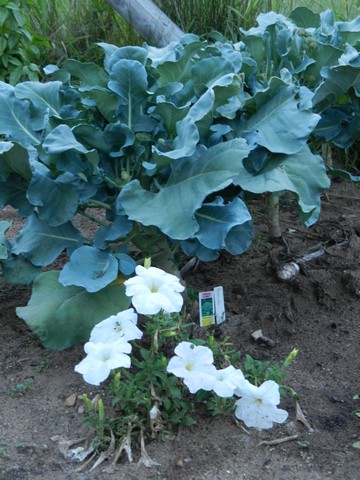
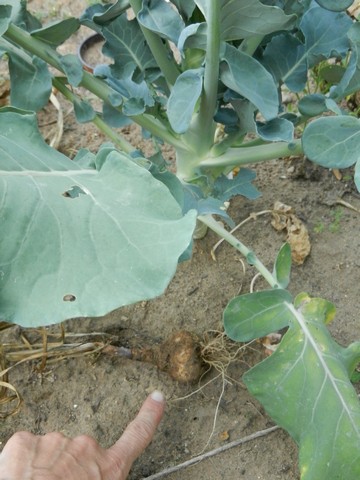
I didn’t notice the garlic scent myself, but I imagine bugs would. If they can smell broccoli from “a mile away”, they can certainly smell a garlic bulb within a foot from the plant. I did see some leaves chewed up from time to time, but this was kept to a minimum, and searching for worms rarely produced any results. So I am very happy with my broccoli this year! I think the garlic probably did have a positive effect on my garden as a whole.
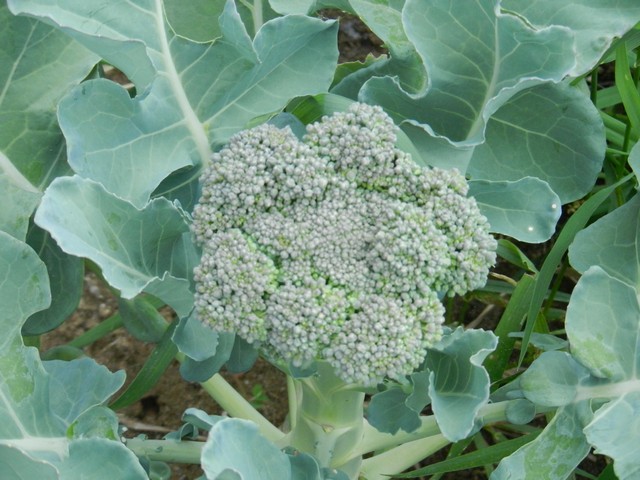
BASIL
I did plant several basil plants around my tomatoes, hoping to see a reduction of tomato hornworms. Whether it helped or not is hard to say. I am inclined to say that it didn’t make a huge difference, as I found several worms this year just like in other years. But basil and tomato plants thrive together regardless, is said to improve the flavor of tomatoes, and basil is a very useful herb in recipes in addition to the positive effect it’s supposed to have on various worms. And who knows, if I had not planted them, maybe the infestation would have been worse.
Two basil plants to the left of a tomato plant.
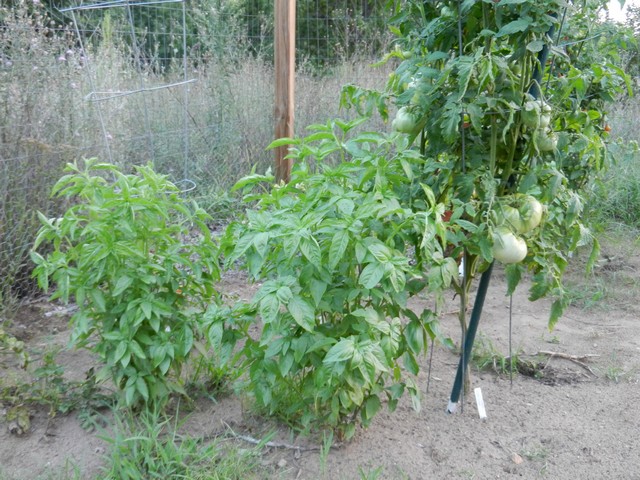
Mosquitoes were at an all-time low this year in our area. Basil is supposed to help deter them, but there simply were not enough mosquitoes around to determine whether it was helpful or not. But you know what, I’m totally OK with that! I’m fine with not knowing as long as they don’t show up in the first place!
OREGANO
I had decided I would not plant oregano, because of how invasive this plant can be. Well, I changed my mind. I did purchase a package of seeds, and ended up putting three plants in pots in-ground, directly into the vegetable garden. I put one pot by my broccoli, and two by my cucumbers. So far the broccoli is doing great, though my cucumber plant has some issue going on with the leaves at this point (August.) I don’t know whether it’s illness, bugs, or a soil problem. But at least so far so good for my broccoli. I dug the pots down into the ground, and pulled them out routinely throughout the season to check for roots growing out of the pots, in order to prevent the oregano from spreading.
Oregano by cucumbers, while cucumber plant was still healthy looking.
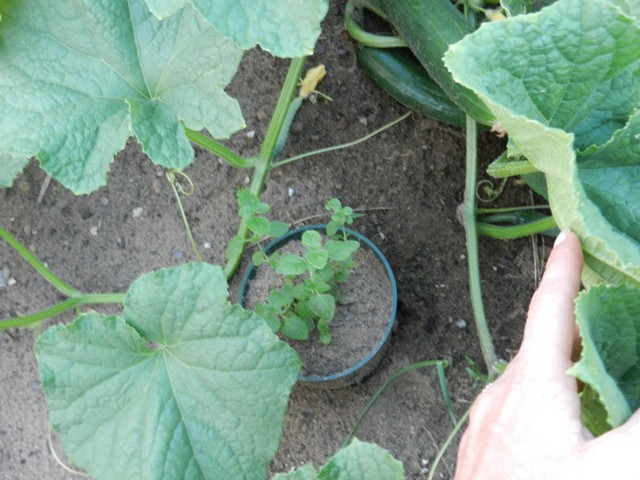
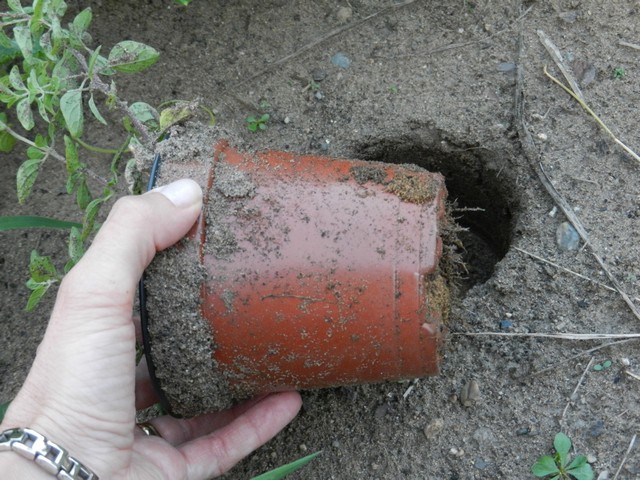
If I see tiny roots growing out of the pots, I just pull them off. I do this several times a week while I’m out in the garden anyway. So far they have not spread at all. The plants did grow very slowly and remained quite small throughout the season; they may have taken off much better had I switched to larger pots after a while. It’s on my to-do list. Keeping the oregano in pots and checking on them did not seem like any work added, it was easy and quick to do.
DILL
I seeded some dill as well, but they never sprouted. I did not bother seeding over again, as I wasn’t really interested in the plant for cooking purposes this year, so I decided to leave it alone. So I can’t tell you how that would have worked out as far as pest control.
LAVENDER
One of the plants I was very excited about planting this year, was lavender. Unfortunately, I never got to see these plants in bloom. I wasn’t sure whether they could be purchased in pots, and being that I enjoy seeding my own plants, I decided to go that route. That did not work out very well for lavender. There were two main problems: The plants stayed tiny for a long time, and seemed like extremely slow growers. I don’t know if there was a problem with my plants or whether they are notoriously slow growers, but if I am to do plant lavender again, I will try to purchase potted plants or start them from seed much, much earlier in order to give them a good head start.
The second, and much bigger problem, was that the little lavender sprouts looked so much like the weeds growing in my garden, that my kids and I ended up pulling them out with the rest of the weeds. I had even put plastic markers by the plants, but we still took them for weeds and yanked them out of there before realizing what we were doing. So none of them ever made it to a fraction of the size they should have grown to. I will most likely try to purchase them in pots next year, and try again.
Lavender seedlings

MARIGOLD
As far as marigold, I was very unsure whether I should attempt planting these, due to the possibility of attracting snails and spider mites. I decided to go for it, and didn’t have a problem with either one. I planted them from seed. When ready to transplant, I planted them around the perimeter of my strawberry patch to try to keep out chipmunks. Since my strawberry patch is rather large, I didn’t end up having nearly enough plants. These too took a long time to grow and produce the flowers needed, so it’s probably a better idea for me to buy them in flats, or seed much earlier to have them ready to bloom in the beginning of the season. Did they help deter chipmunks? Well, that’s hard to say, unfortunately. My cat, being an indoor / outdoor cat, ended up catching several of the chipmunks around our house this year, so the number of them were down anyway. I still did find berries that were partly eaten, but not nearly as many as other years. I am hard pressed to say that the marigold is the reason, being that they should have been planted much closer together than they were. But you never know, they could have helped a smidgin.
Marigold
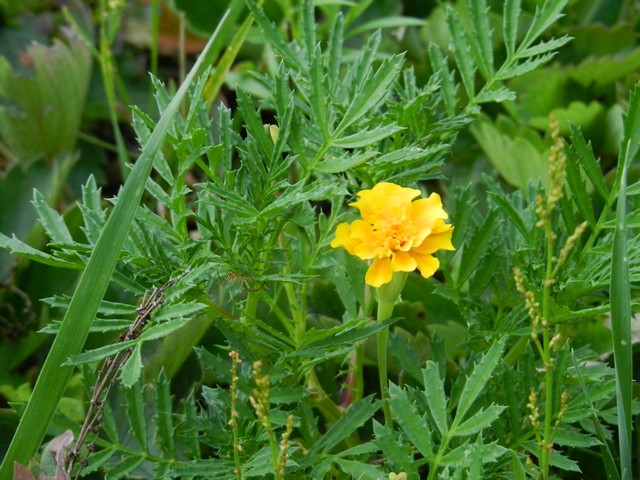
All in all, I can’t say that I was too impressed with the results. Still, since this my first season to experiment with adding herbs and flowers to use as pest control, I don’t have sufficient experience to say that it does not work. I think the various plants did have a limited effect on my garden as a whole, and was especially helpful for my broccoli. In addition, it probably takes a lot denser planting to fully protect against bugs and pests.

Very interesting about these plant for bugs thankyou
Thank you for this. Very helpful.
You’re very welcome! Thank you for your comment!
I put marigolds throughout my garden every year and never have bugs or worms. I swear by them!!! I don’t do anything else, no pesticides!!
That’s wonderful!! It is so nice to be able to avoid those nasty chemicals!
Thanks for the info. This is my second year trying my hand at gardening. So far pretty good. Love that your info is easy to understand, thank you.
I planted corn last year and ants (or what looked like little ants) took over. I had to dig up the corn stalks and throw them away. Do you have any idea how to keep ants off my corn? I do not want to use any chemicals.
Interesting! And what a bummer!! Let me give you some input on this:
Usually ants are not interested in crops as they are carnivores, but what can sometimes happen is an aphid infestation. Aphids are also little bugs and can sometimes resemble ants a little bit. Interestingly, the two actually often work together, so you may have had both. Aphids suck sap, and leave a sweet secretion that ants love, and the ants will protect the aphids from predators. And aphids go after a lot of different plants. If you do have ants in addition to aphids, try to wrap the bottom of each stalk with sticky tape so that ants can’t climb up to be protectors, that way other insects might be able to eliminate the aphids. I don’t have much experience with aphids myself, but here’s a paragraph from a site that explains what you can do to get rid of them:
“Aphids have a number of natural enemies, and these insects are much better at controlling aphids than any other method available to gardeners. Pampering and nurturing their natural enemies is an excellent method of organic aphid control. Introduce beneficial bugs, like lacewings and ladybugs, to your garden as a natural way to kill aphids. Nearby plantings of mint, fennel, dill, yarrow, and dandelions will help attract these insects to your garden.”
Read more at Gardening Know How: Killing Aphids Naturally: How To Get Rid Of Aphids Safely http://www.gardeningknowhow.com/plant-problems/pests/insects/homemade-aphid-control.htm
I hope that helps!
Thank you so much!
You’re very welcome! Glad I could help!
Thanks for sharing this. Organic pest control really works when we want naturally get rid of pest. Organic pest are really helpful for our environment to avoid chemicals products that are harmful to farming.
Great article. I really appreciate the insight here in this post and confident it’s going to be helpful to me and many others. Thanks for sharing it.
I just wanted to share my experience with tomato plants. Last year, every tomato (I grow in bags) had a marigold, a basil, and a small group of chives. The chives were stated by putting a few chives seeds in the dirt. I had no tomato hornworms, and the tomatoes were delicious. I dug out some of the chive plants for inside, but left several outside where they have grown, multiplied, and blossomed. I will be digging them out and dividing them among my tomato plants, all my brassicas, and squash. Don’t plant chives near beans, peas, lentils and parsley.
Mint is another powerful bug deterrent, but don’t plant it in the ground! Put it in a pot near your plants.
Thank you for your insights, smart thinking to put chives with the tomatoes!